Conceptualizing a Methodology for Cultural Heritage Futures: Using Futurist Hindsight to Make ‘Known Unknowns’ Knowable
Abstract
“there are known knowns…we also know there are known unknowns…but there are also unknown unknowns…”(Donald Rumsfeld 2002)[1]
1. Introduction
2. Contextualization
Contextualization: Current Processes
3. Conceptualization: Theoretical Foundations
3.1. Stewardship
3.2. The Precautionary Principle
“In order to protect the environment, the precautionary approach shall be widely applied by states according to their capabilities. Where there are threats of serious or irreversible damage, lack of full scientific certainty shall not be used as a reason for postponing cost-effective measures to prevent environmental degradation” (principle 15 of the Rio Declaration).[77]
“Where action is deemed necessary, measures based on the precautionary principle should be, inter alia: proportional to the chosen level of protection; non-discriminatory in their application; consistent with similar measures already taken; based on an examination of the potential benefits and costs of action or lack of action (including, where appropriate and feasible, an economic cost/benefit analysis); subject to review, in the light of new scientific data, and capable of assigning responsibility for producing the scientific evidence necessary for a more comprehensive risk assessment”.[79]
The Precautionary Principle and Cultural Heritage Management
3.3. Future Studies and Strategic Foresight
“The Museum of Contemporary Art proceeds from the underlying premise that to remain contemporary is to assume a confident and aggressive posture in its approach to art at the moment it is being created. The museum will pursue a dynamic balance in its programs and collection, ensuring consistent inclusion of art that is presently emerging along with work of historic significance”.[103]
4. Converting Known Unknowns into Knowable Realities
5. The Role of the Unknown Unknowns
6. Conclusions
Funding
Data Availability Statement
Conflicts of Interest
References
- Rumsfeld, D. Transcript: DoD News Briefing—Secretary Rumsfeld and Gen. Myers. Available online: https://web.archive.org/web/20190226145016/http://archive.defense.gov/Transcripts/Transcript.aspx?TranscriptID=2636 (accessed on 25 August 2022).
- Spennemann, D.H.R. The Futurist Stance of Historical Societies: An analysis of positioning statements. Int. J. Arts Manag. 2007, 9, 4–15. [Google Scholar]
- Högberg, A.; Holtorf, C. Heritage futures and the future of heritage. In Counterpoint: Essays in Archaeology and Heritage Studies in Honour of Professor Kristian Kristiansen; Bergerbrant, S., Sabatini, S., Eds.; Archaeopress: Oxford, UK, 2013; pp. 739–746. [Google Scholar]
- Holtorf, C.; Bolin, A. Heritage futures: A conversation. J. Cult. Herit. Manag. Sustain. Dev. 2022. [Google Scholar] [CrossRef]
- Vecco, M. A definition of cultural heritage: From the tangible to the intangible. J. Cult. Herit. 2010, 11, 321–324. [Google Scholar] [CrossRef]
- Pearson, M.; Sullivan, S. Looking after Heritage Places: The Basics of Heritage Planning for Managers, Landowners and Administrators; Melbourne University Press: Carton, VIC, Australia, 1995. [Google Scholar]
- Heredia-Carroza, J.; Palma Martos, L.; Aguado, L.F. How to Measure Intangible Cultural Heritage Value? The Case of Flamenco in Spain. Empir. Stud. Arts 2020, 39, 149–170. [Google Scholar] [CrossRef]
- Maffei, M.C. Culinary traditions as cultural intangible heritage and expressions of cultural diversity. In Cultural Heritage, Cultural Rights, Cultural Diversity; Brill Nijhoff: Leiden, The Netherlands, 2012; pp. 223–249. [Google Scholar]
- Parker, M.; Spennemann, D.H.R. Stille Nacht: COVID and the ghost of Christmas 2020. Heritage 2021, 4, 3081–3097. [Google Scholar] [CrossRef]
- Ministère de la Culture. La loi Relative au Patrimoine Culturel—Un Guide Pratique; Ministre de la Culture, Le Gouvernement du Grand-Duché de Luxembourg: Luxembourg, 2022.
- UNESCO. Basic Texts of the 2003 Convention for the Safeguarding of Intangible Cultural Heritage’ for Its Protection and Promotion; UNESCO: Paris, France, 2020. [Google Scholar]
- Smith, G.S.; Messenger, P.M.; Soderland, H.A. Heritage Values in Contemporary Society; Routledge: London, UK, 2017. [Google Scholar]
- Spennemann, D.H.R. Gauging Community Values in Historic Preservation. CRM J. Herit. Steward. 2006, 3, 6–20. [Google Scholar]
- Fredheim, L.H.; Khalaf, M. The significance of values: Heritage value typologies re-examined. Int. J. Her. Stud. 2016, 22, 466–481. [Google Scholar] [CrossRef]
- Spennemann, D.H.R. The Nexus between Cultural Heritage Management and the Mental Health of Urban Communities. Land 2022, 11, 304. [Google Scholar] [CrossRef]
- ICOMOS Australia. The Burra Charter: The Australia ICOMOS Charter for Places of Cultural Significance 2013; Australia ICOMOS Inc. International Council of Monuments and Sites: Burwood, VIC, Australia, 2013. [Google Scholar]
- Australian Heritage Commission, Future Directions in Assessing National Estate Significance. Forests and the National Estate Part 2; Australian Heritage Commission: Canberra, ACT, Australia, 1990.
- U.S. Department of the Interior. The Secretary of the Interior’s Standards for Rehabilitation and Guidelines for Rehabilitating Historic Buildings (36 CFR 67); Technical Preservation Services, National Park Service; U.S. Department of the Interior: Washington, DC, USA, 2011.
- Murtagh, W.J. Keeping Time: The History and Theory of Preservation in America; John Wiley and Sons: New York, NY, USA, 1997. [Google Scholar]
- ICOMOS. International Charter for the Conservation and Restoration of Monuments and Sites, Venice; ICOMOS: Paris, France, 1964. [Google Scholar]
- Jokilehto, J. The context of the Venice Charter (1964). Conserv. Manag. Archaeol. Sites 1998, 2, 229–233. [Google Scholar] [CrossRef]
- Johnston, C. What Is Social Value?: A Discussion Paper; Australian Government Publishing Service: Canberra, ACT, Australia, 1992.
- Spennemann, D.H.R. Your solution, their problem. Their solution, your problem: The Gordian Knot of Cultural Heritage Planning and Management at the Local Government Level. DisP 2006, 42, 30–40. [Google Scholar] [CrossRef]
- Spennemann, D.H.R. The Shifting Baseline Syndrome and Generational Amnesia in Heritage Studies. Heritage 2022, 5, 2007–2027. [Google Scholar] [CrossRef]
- Australian Heritage Commission. Australian Natural Heritage Charter for the Conservation of Places of Natural Heritage Significance; Australian Heritage Commission, Environment Australia: Canberra, ACT, Australia, 2002.
- Aldred, J. Existence value, welfare and altruism. Environ. Values 1994, 3, 381–402. [Google Scholar] [CrossRef]
- Davidson, M.D. On the relation between ecosystem services, intrinsic value, existence value and economic valuation. Ecol. Econ. 2013, 95, 171–177. [Google Scholar] [CrossRef]
- Spennemann, D.H.R. The usefulness of the Johari Window for the Cultural Heritage Planning Process. Heritage 2023, in press. [Google Scholar]
- Spennemann, D.H.R. Beyond “Preserving the Past for the Future”: Contemporary Relevance and Historic Preservation. CRM J. Herit. Steward. 2011, 8, 7–22. [Google Scholar]
- Lekakis, S.; Dragouni, M. Heritage in the making: Rural heritage and its mnemeiosis at Naxos island, Greece. J. Rural. Stud. 2020, 77, 84–92. [Google Scholar] [CrossRef]
- Australian Heritage Commission. Australian Historic Themes: A Framework for Use in Heritage Assessment and Management; Australian Heritage Commission: Canberra, ACT, Australia, 2001.
- NSW Heritage Office. New South Wales Historical Themes: Table Showing Correlation of National, State and Local Themes, with Annotations and Examples; NSW Heritage Office: Sydney, NSW, Australia, 2001.
- NSW Heritage Office. Assessing Heritage Significance; NSW Heritage Office: Sydney, NSW, Australia, 2001; Volume 2.
- Heritage Council of Victoria. Assessing the Cultural Heritage Significance of Places and Objects for Possible State Heritage Listing: The Victorian Heritage Register Criteria and Threshold Guidelines; Heritage Council of Victoria: Melbourne, VIC, Australia, 2020.
- SA Heritage Council. Guidelines for Interpreting State Heritage Criteria: Assessing Places for State Heritage Listing; South Australian Heritage Council: Adelaide, SA, Australia, 2020.
- Smith, L.; Waterton, E. Constrained by commonsense: The authorized heritage discourse in contemporary debates. In The Oxford Handbook of Public Archaeology; Skeates, R., McDavid, C., Carman, J., Eds.; Oxford University Press: Oxford, UK, 2012; pp. 153–171. [Google Scholar]
- DOCOMOMO International. The Eindhoven Statement; DOCOMOMO International: Eindhoven, The Netherlands, 1990. [Google Scholar]
- Alatlı, H.İ.; Binan, D. The Original Architect’s Role in Conservation of The Recent Architectural Heritage. In Proceedings of the ICONARCH International Congress of Architecture and Planning, 13–15 October 2020; Online; pp. 267–278. [Google Scholar]
- Sherfy, M.; Luce, W.R. Guidelines for Evaluating and Nominating Properties that Have Achieved Significance within the Past Fifty Years; US Department of the Interior, National Park Service, National Register of Historic Places: Washington, DC, USA, 1996; Volume 22.
- Andrus, P.W.; Savage, B.L.; Pope, S.D. How to Apply the National Register Criteria for Evaluation. Natl. Regist. Bull. 1998, 15, 1–54. [Google Scholar]
- Longstreth, R. When the present becomes the past. In Past Meets Future. Saving America’s Historic Environments; Lee, A., Ed.; The Preservation Press: Washington, DC, USA, 1992; pp. 213–225. [Google Scholar]
- Kelly, C. New Opportunities. Historic Preservation Tax Incentives and the Recent Past. Available online: https://web.archive.org/web/20041112191436/http://www.cr.nps.gov/hps/tps/recentpast/twentietharticle.htm (accessed on 2 August 2022).
- Yoder, D.T. Interpreting the 50-year rule: How a simple phrase leads to a complex problem. Adv. Archaeol. Pract. 2014, 2, 324–337. [Google Scholar] [CrossRef]
- Douet, J. Industrial Heritage Re-Tooled: The TICCIH Guide to Industrial Heritage Conservation; Routledge: Abingdon, UK, 2016. [Google Scholar]
- Alfrey, J.; Putnam, T. The Industrial Heritage: Managing Resources and Uses; Routledge: Abingdon, UK, 2003. [Google Scholar]
- Hudson, K. Industrial Archaeology: An Introduction; Routledge: Abingdon, UK, 2014. [Google Scholar]
- Spennemann, D.H.R. The Ethics of treading on Neil Armstrong’s Footprints. Space Policy 2004, 20, 279–290. [Google Scholar] [CrossRef]
- Spennemann, D.H.R.; Kosmer, L. Heritage sites of the US Space Program in Australia: Are we managing them adequately? QUEST Hist. Spacefl. Q. 2005, 12, 52–64. [Google Scholar]
- O’Leary, B.L. The cultural heritage of space, the Moon and other celestial bodies. Antiquity 2006, 80. Available online: https://web.archive.org/web/20110927094247/http://antiquity.ac.uk/Projgall/oleary/ (accessed on 2 November 2022).
- O’Leary, B.L. One Giant Leap for Preservation: Protecting Moon Landing Sites. The Conversation. 2014. Available online: https://theconversation.com/one-giant-leap-for-preservation-protecting-moon-landing-sites-33139 (accessed on 15 November 2022).
- Spennemann, D.H.R. On the Nature of the Cultural Heritage Values of Spacecraft Crash Sites? In Handbook of Space Engineering, Archaeology and Heritage; Darrin, A., O’Leary, B.L., Eds.; CRC Press: London, UK, 2009; pp. 781–800. [Google Scholar]
- Spennemann, D.H.R.; Murphy, G. Failed Mars Mission Landing Sites: Heritage Places Or Forensic Investigation Scenes. In Handbook of Space Engineering, Archaeology and Heritage; Darrin, A., O’Leary, B.L., Eds.; CRC Press: London, UK, 2009; pp. 457–479. [Google Scholar]
- Gorman, A. The cultural landscape of interplanetary space. J. Soc. Archaeol. 2005, 5, 85–107. [Google Scholar] [CrossRef]
- Gorman, A. The Anthropocene in the solar system. J. Contemp. Archaeol. 2014, 1, 87–91. [Google Scholar] [CrossRef]
- Sarkissian, J.M. On eagle’s wings: The Parkes observatory’s support of the Apollo 11 mission. Publ. Astron. Soc. Aust. 2001, 18, 287–310. [Google Scholar] [CrossRef]
- Robertson, P. Beyond Southern Skies: Radio Astronomy and the Parkes Telescope; Cambridge University Press: Cambridge, UK, 1992. [Google Scholar]
- Bowen, E. History of Australian Astronomy: The Pre-History of the Parkes 64-m Telescope. Publ. Astron. Soc. Aust. 1981, 4, 267–273. [Google Scholar] [CrossRef]
- Orchiston, W. The Parkes 18-m Antenna: A brief historical evaluation. J. Astron. Hist. Herit. 2012, 15, 96–99. [Google Scholar]
- Graham, K.; Spennemann, D.H.R. Heritage managers and their Attitudes towards Disaster Management for cultural heritage resources in New South Wales, Australia. Int. J. Emerg. Manag. 2006, 3, 215–237. [Google Scholar] [CrossRef]
- Nethery, A. ‘A modern-day concentration camp’: Using history to make sense of Australian immigration detention centres. In Does History Matter?: Making and Debating Citizenship; Neumann, K., Gwenda, T., Eds.; Australian National University: Canberra, ACT, Australia, 2009; pp. 65–80. [Google Scholar]
- Gorman, A. La terre et l’espace: Rockets, prisons, protests and heritage in Australia and French Guiana. Archaeologies 2007, 3, 153–168. [Google Scholar] [CrossRef]
- Spennemann, D.H.R. COVID-19 on the ground: Heritage sites of a pandemic. Heritage 2021, 3, 2140–2162. [Google Scholar] [CrossRef]
- Bennett, N.J.; Whitty, T.S.; Finkbeiner, E.; Pittman, J.; Bassett, H.; Gelcich, S.; Allison, E.H. Environmental stewardship: A conceptual review and analytical framework. Environ. Manag. 2018, 61, 597–614. [Google Scholar] [CrossRef]
- Mathevet, R.; Bousquet, F.; Larrère, C.; Larrère, R. Environmental stewardship and ecological solidarity: Rethinking social-ecological interdependency and responsibility. J. Agric. Environ. Ethics 2018, 31, 605–623. [Google Scholar] [CrossRef]
- Lowenthal, D. Stewarding the Future. CRM J. 2005, 2, 20–39. [Google Scholar] [CrossRef]
- Morris, J. Rethinking Risk and the Precautionary Principle; Butterworth-Heinemann: Oxford, UK, 2000. [Google Scholar]
- Bonnici, U.M. Opening Plenary Addresses by His Excellency Dr Ugo Mifsud Bonnici, President Emeritus of Malta. In Proceedings of the 6th European Commission Conference ‘Sustaining Europe’s Cultural Heritage: From Research to Policy’, London, UK, 1–3 September 2004. [Google Scholar]
- Southwark. London Borough of Southwark: Southwark Discovery Centre Business Plan: November 2005; Borough of Southwark: London, UK, 2005.
- Ministry of Agriculture and Food. Preservation of Cultural Landscapes. Available online: https://www.regjeringen.no/en/topics/food-fisheries-and-agriculture/landbrukseiendommer/innsikt/jordvern/bevaring-av-kulturlandskap/id2009572/ (accessed on 3 August 2022).
- MACC. New Thrust of MACC: Dissemination and Outreach. Available online: https://web.archive.org/web/20051214113402/http://www.aam-rcam.org/features2.htm (accessed on 3 August 2022).
- Hartkopf, G.; Bohne, E. Umweltpolitik 1: Grundlagen, Analysen und Perspektiven; Westdeutscher Verlag: Opladen, Germany, 1983. [Google Scholar]
- Werner, S. Das Vorsorgeprinzip–Grundlagen, Maßstäbe und Begrenzungen. Umw. Plan. 2001, 21, 335–340. [Google Scholar]
- Rachewiltz, M.d. Das Vorsorgeprinzip Revisited–Ansätze einer Umweltethik für das 21. Jahrhundert. In Transformation und Wachstum; Springer: Berlin, Germany, 2021; pp. 109–122. [Google Scholar]
- Stein, P.L. Are Decision-makers Too Cautious with The Precautionary Principle? Speech delivered by The Hon. Justice Paul L Stein AM, Judge, NSW Court of Appeal, Supreme Court of New South Wales, Sydney. In Proceedings of the Land and Environment Court of New South Wales Annual Conference, Medlow Bath, NSW, Australia, 14–15 October 1999. [Google Scholar]
- Feintuck, M. Precautionary maybe, but what’s the principle? The precautionary principle, the regulation of risk, and the public domain. J. Law Soc. 2005, 32, 371–398. [Google Scholar] [CrossRef]
- von Krauss, M.K.; Henze, M. Uncertainty and Precaution in Environmental management. Water Sci. Technol. 2004, 52, 1–9. [Google Scholar] [CrossRef]
- Rio Declaration. Rio Declaration on Environment and Development (Adopted in 1992 by the United Nations Conference on Environment and Development [UNCED] in Rio de Janeiro; UNCED: New York, NY, USA, 1992. [Google Scholar]
- Calzada, G.; Philippe, C.; Méra, X. The Precautionary Principle: A High-Risk Principle 1. Econ. Aff. 2005, 25, 60–62. [Google Scholar] [CrossRef]
- Commission of the European Communities. Communication from the Commission on the Precautionary Principle: Brussels, 2 February 2000. COM2000) 1 Final. Available online: https://web.archive.org/web/20090325192508/http://ec.europa.eu/dgs/health_consumer/library/pub/pub07_en.pdf (accessed on 3 August 2022).
- Weckert, J. In defence of the precautionary principle. In Proceedings of the 2010 IEEE International Symposium on Technology and Society, Wollongong, NSW, Australia, 7–9 June 2010; pp. 42–47. [Google Scholar]
- Green, L.W.; Fielding, J.E.; Brownson, R.C. The debate about electronic cigarettes: Harm minimization or the precautionary principle. Annu. Rev. Public Health 2018, 39, 189–191. [Google Scholar] [CrossRef]
- Weir, E.; Schabas, R.; Wilson, K.; Mackie, C. A Canadian framework for applying the precautionary principle to public health issues. Can. J. Public Health 2010, 101, 396–398. [Google Scholar] [CrossRef]
- Weckert, J.; Moor, J. The precautionary principle in nanotechnology. Int. J. Appl. Philos. 2006, 20, 191–204. [Google Scholar] [CrossRef]
- Garcia, D. Lethal artificial intelligence and change: The future of international peace and security. Int. Stud. Rev. 2018, 20, 334–341. [Google Scholar] [CrossRef]
- Clarke, S. Future technologies, dystopic futures and the precautionary principle. Ethics Inf. Technol. 2005, 7, 121–126. [Google Scholar] [CrossRef]
- Luft, J.; Ingham, H. The Johari Window, a Graphic Model of Interpersonal Awareness; University of California: Los Angeles, CA, USA, 1955. [Google Scholar]
- Luft, J.; Ingham, H. The Johari window. Hum. Relat. Train. News 1961, 5, 6–7. [Google Scholar]
- Gleich, A.v. Vorsorgeprinzip. In Handbuch Technikfolgenabschätzung, Berlin; Bröchler, S., Simonis, G., Sundermann, K., Eds.; Edition Sigma: Berlin, Germany, 1999; pp. 287–293. [Google Scholar]
- Gollier, C.; Treich, N. Decision-making under scientific uncertainty: The economics of the precautionary principle. J. Risk Uncertain. 2003, 27, 77–103. [Google Scholar] [CrossRef]
- IUCN. The Legal Tools for World Heritage Conservation. In Proceedings of the International Workshop World Heritage 2002 Shared Legacy, Common Responsibility Associated Workshops, Siena, Italy, 11–12 November 2002. [Google Scholar]
- Weaver, M.E.; Matero, F.G. Conserving Buildings: Guide to Techniques and Materials; John Wiley and Sons: New York, NY, USA, 1997. [Google Scholar]
- NPWS. Aboriginal Cultural Heritage: Standards and Guidelines Kit; New South Wales National Parks and Wildlife Service: Sydney, NSW, Australia, 1997.
- Soga, M.; Gaston, K.J. Shifting baseline syndrome: Causes, consequences, and implications. Front. Ecol. Environ. 2018, 16, 222–230. [Google Scholar] [CrossRef]
- Pauly, D. Anecdotes and the shifting baseline syndrome of fisheries. Trends Ecol. Evol. 1995, 10, 430. [Google Scholar] [CrossRef] [PubMed]
- Jones, H. New buildings on list. Border Mail (Albury), 1 September 2004. [Google Scholar]
- Slaughter, R.A. Futures for the Third Millennium—Enabling the Forward View; Prospect: Sydney, NSW, Australia, 2000. [Google Scholar]
- Butowsky, H.A. Man in Space: A National Historic Landmark Theme Study; National Park Service, U.S. Department of the Interior, U.S.A: Washington, DC, USA, 1984.
- Campbell, J.B. Assessing and Managing Human Space Heritage in the Solar System: The Current State of Play and Some Proposals. In Proceedings of the World Archaeological Congress 5: Themes The Heavens Above: Archaeoastronomy, Space Heritage And SETI, Washington, DC, USA, 21–26 June 2003. [Google Scholar]
- Barclay, R.; Brooks, R. In situ preservation of historic spacecraft. J. Br. Interplanet. Soc. 2002, 55, 173–181. [Google Scholar]
- Gorman, A. The archaeology of orbital space. In Proceedings of the 5th NSSA Australian Space Science Conference: 14 to 16 September 2005 Hosted by RMIT University, Melbourne, VIC, Australia, 14–16 September 2005; p. 338. [Google Scholar]
- Rogers, T.F. Safeguarding tranquility base: Why the Earth’s moon base should become a world heritage site. Space Policy 2004, 20, 5–6. [Google Scholar] [CrossRef]
- Spennemann, D.H.R. Of Great Apes and Robots: Considering the Future(s) of Cultural Heritage. Futures 2007, 39, 861–877. [Google Scholar] [CrossRef]
- MOCA, The Museum of Contemporary Art, Los Angeles, Collection Management Policy; Approved by the Acquisition and Collection Committee 18 December 1991; Acquisition and Collection Committee: Los Angeles, CA, USA.
- Mietzner, D.; Reger, G. Advantages and disadvantages of scenario approaches for strategic foresight. Int. J. Technol. Intell. Plan. 2005, 1, 220–239. [Google Scholar] [CrossRef]
- Fink, A.; Schlake, O. Scenario management—An approach for strategic foresight. Compet. Intell. Rev. Publ. Coop. Soc. Compet. Intell. Prof. 2000, 11, 37–45. [Google Scholar] [CrossRef]
- van Duijne, F.; Bishop, P. Introduction to strategic foresight. Future 2018, 1, 67. [Google Scholar]
- Inayatullah, S. Neither A Black Swan Nor A Zombie Apocalypse: The Futures Of A World With The Covid-19 Coronavirus. J. Futures Stud. 2020. [Google Scholar]
- Spennemann, D.H.R. HeritageFutures—A new Paradigm to manage the Heritage of Tomorrow. In Proceedings of the Re/theorising heritage. Session “Heritage and the Long Term Future” Inaugural conference of the Association of Critical Heritage Studies, University of Gothenburg, Gothenburg, Sweden, 5–8 June 2012. [Google Scholar]
- Spennemann, D.H.R. Curating the Contemporary: A case for national and local COVID-19 collections. Curator 2022, 65, 27–42. [Google Scholar] [CrossRef] [PubMed]

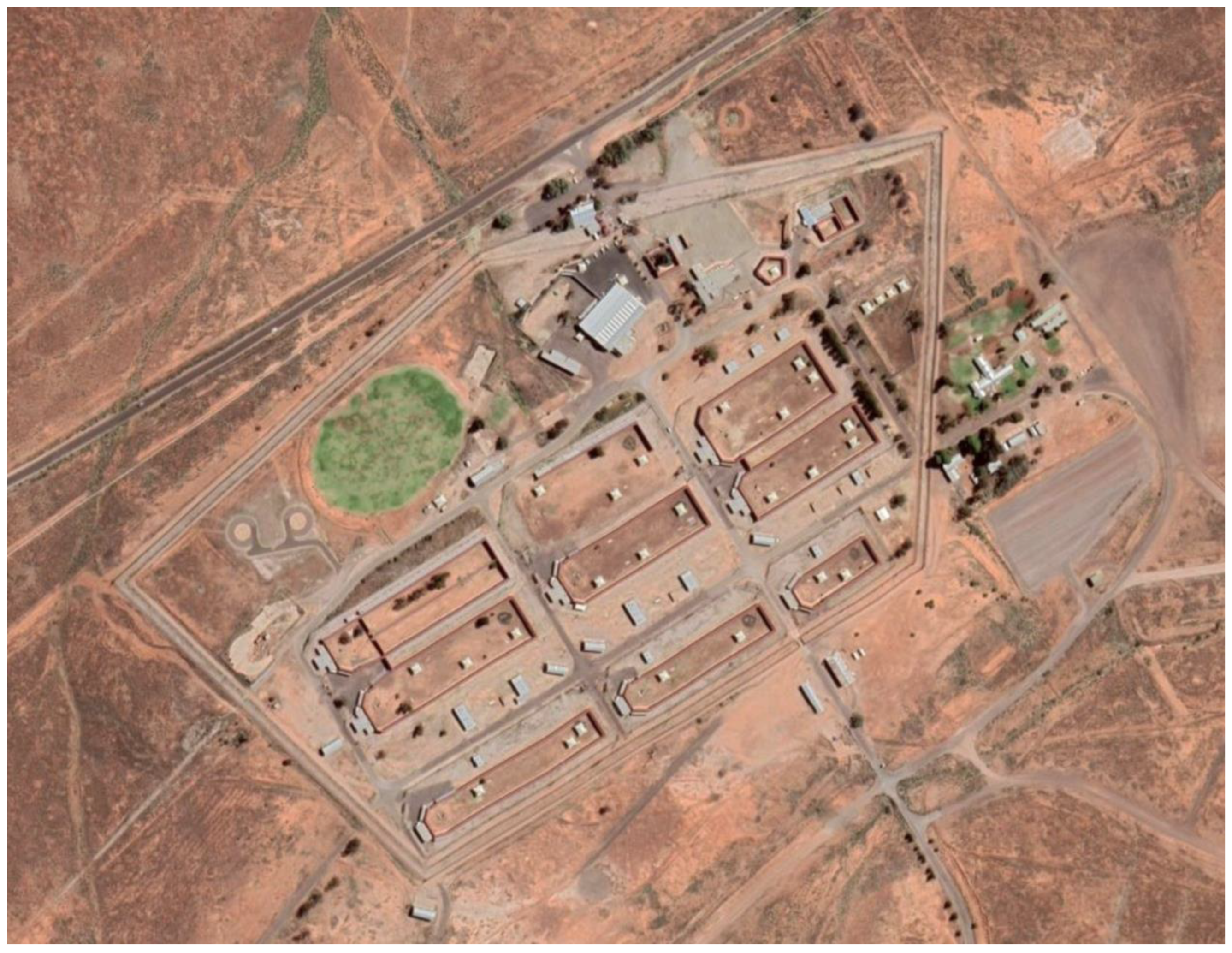
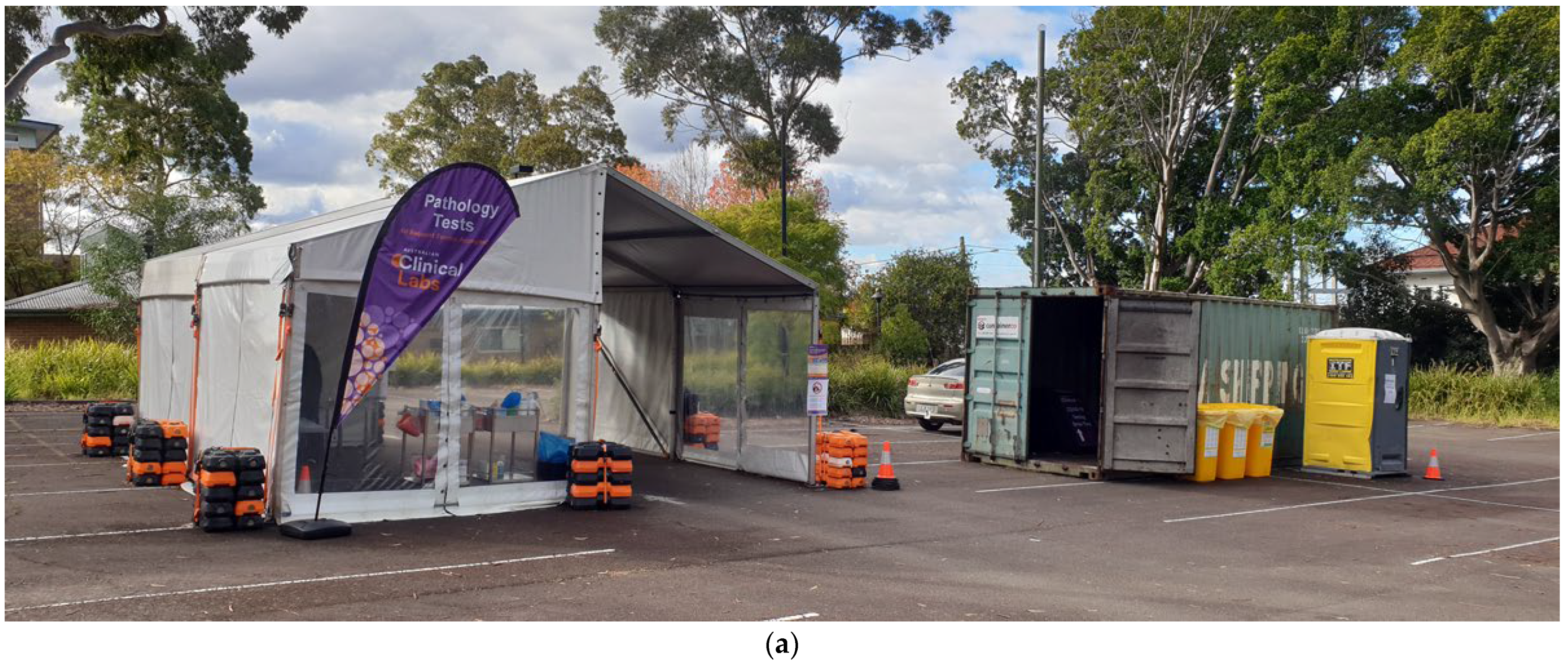
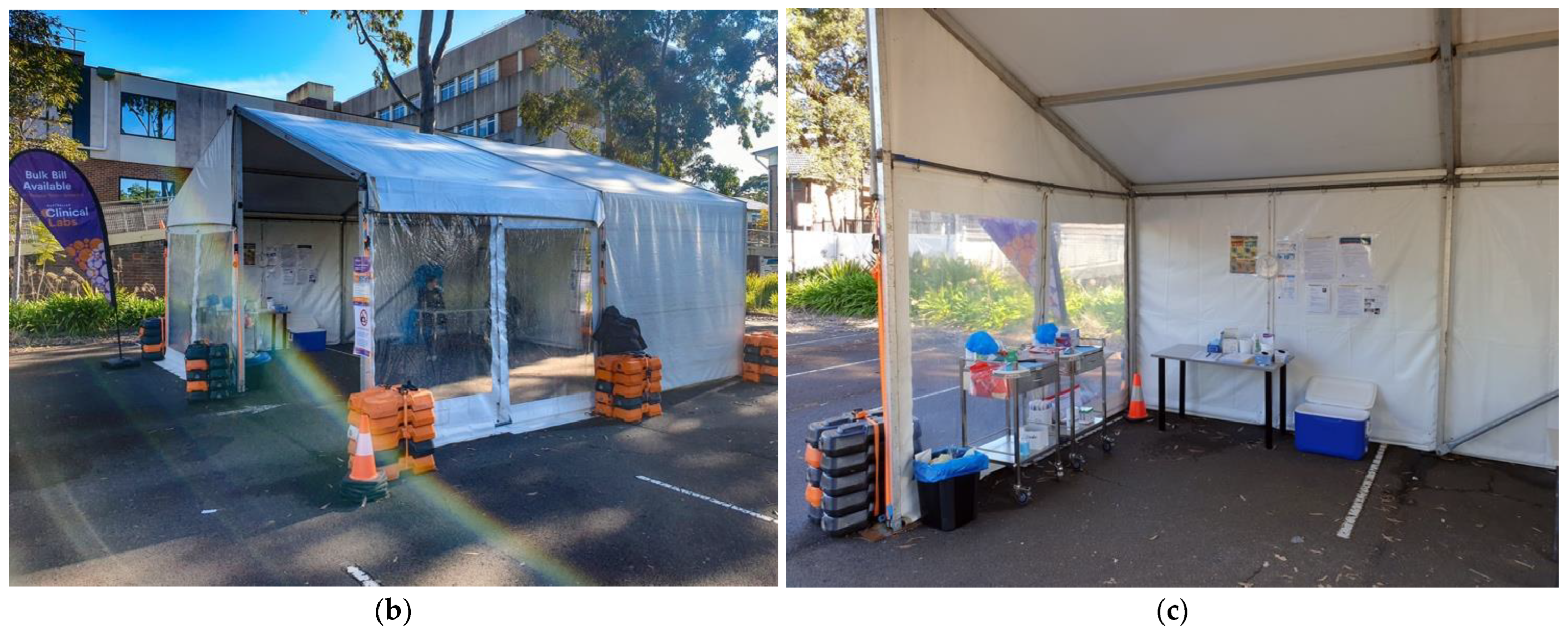
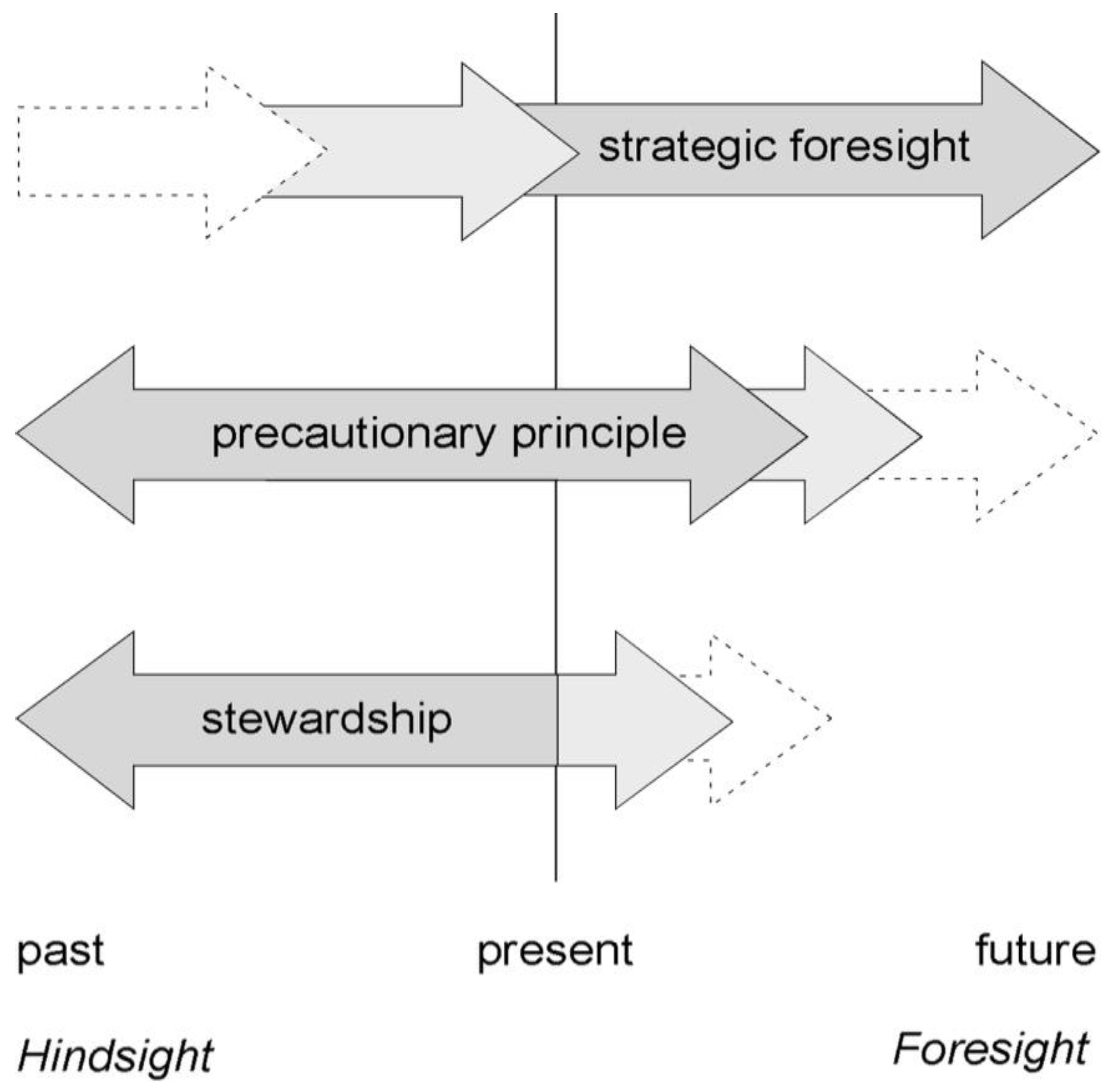
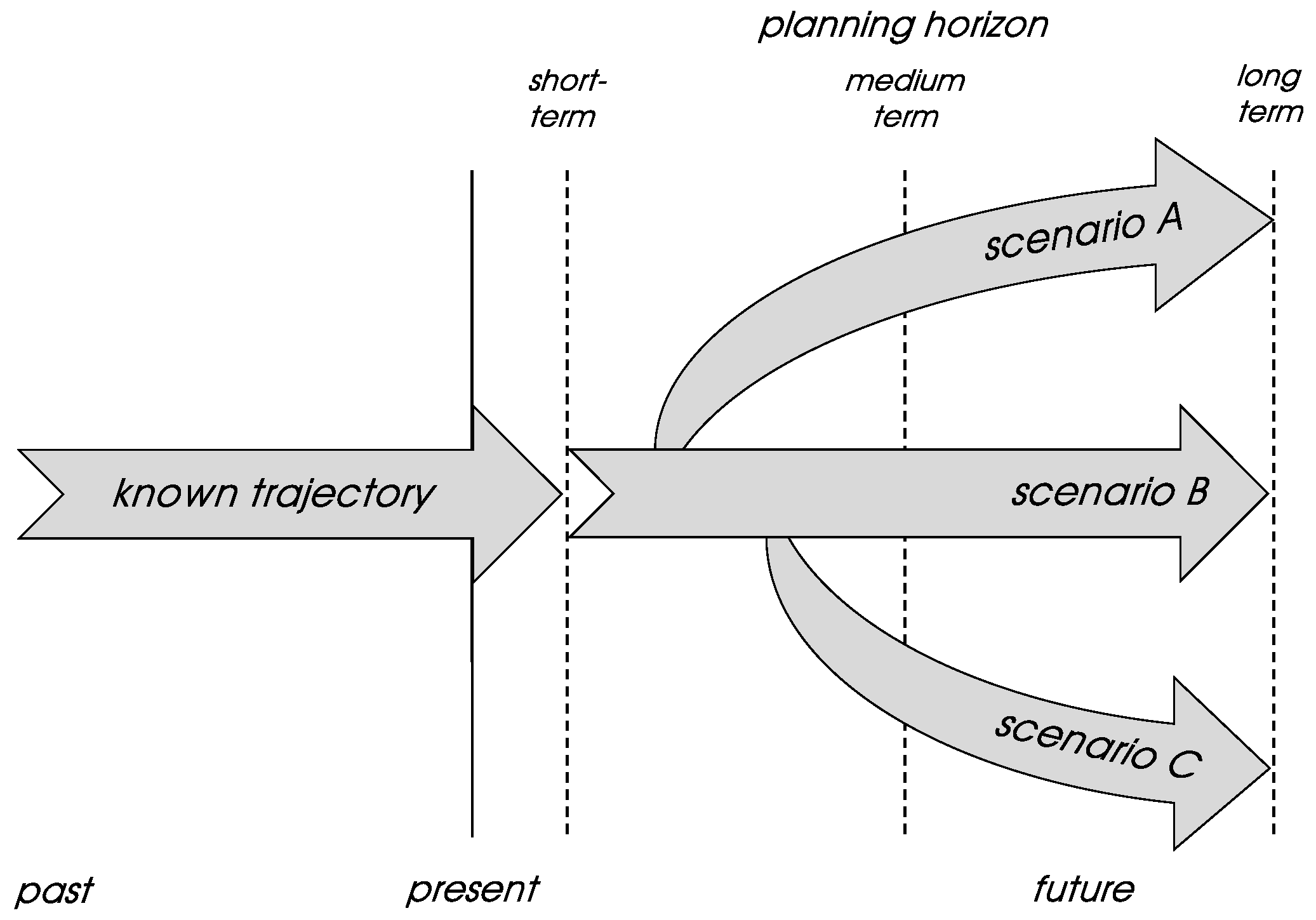
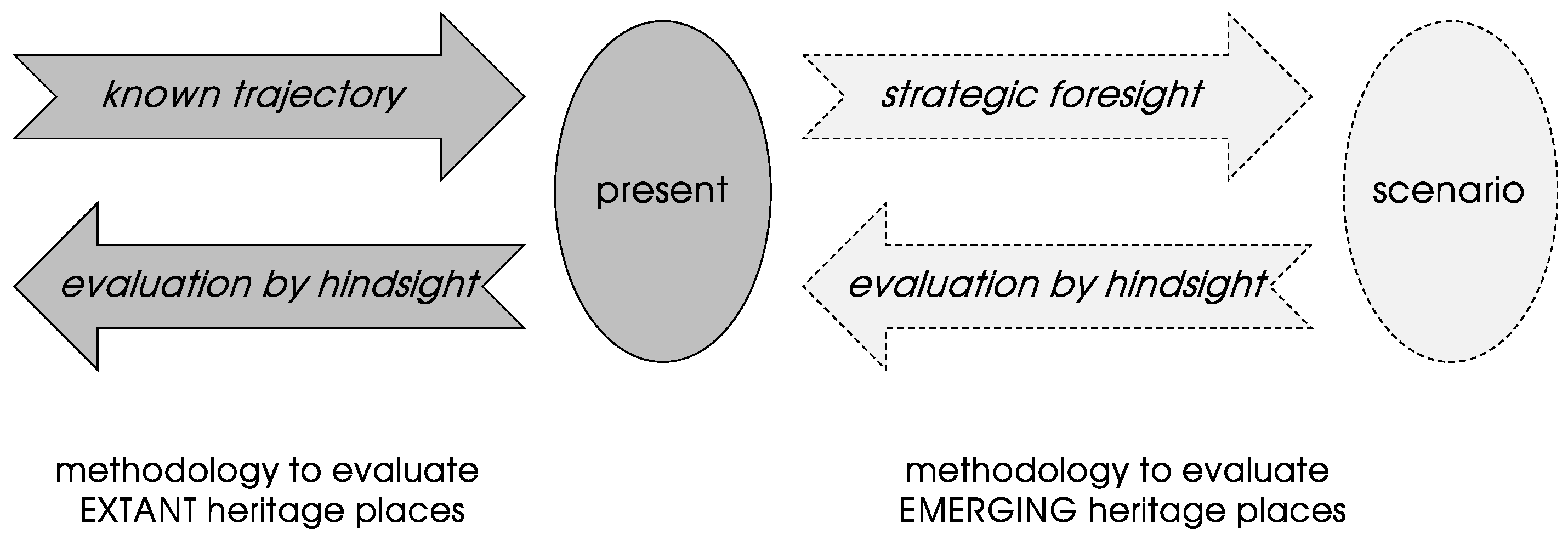
Disclaimer/Publisher’s Note: The statements, opinions and data contained in all publications are solely those of the individual author(s) and contributor(s) and not of MDPI and/or the editor(s). MDPI and/or the editor(s) disclaim responsibility for any injury to people or property resulting from any ideas, methods, instructions or products referred to in the content. |
© 2023 by the author. Licensee MDPI, Basel, Switzerland. This article is an open access article distributed under the terms and conditions of the Creative Commons Attribution (CC BY) license (https://creativecommons.org/licenses/by/4.0/).
Share and Cite
Spennemann, D.H.R. Conceptualizing a Methodology for Cultural Heritage Futures: Using Futurist Hindsight to Make ‘Known Unknowns’ Knowable. Heritage 2023, 6, 548-566. https://doi.org/10.3390/heritage6010029
Spennemann DHR. Conceptualizing a Methodology for Cultural Heritage Futures: Using Futurist Hindsight to Make ‘Known Unknowns’ Knowable. Heritage. 2023; 6(1):548-566. https://doi.org/10.3390/heritage6010029
Chicago/Turabian StyleSpennemann, Dirk H. R. 2023. "Conceptualizing a Methodology for Cultural Heritage Futures: Using Futurist Hindsight to Make ‘Known Unknowns’ Knowable" Heritage 6, no. 1: 548-566. https://doi.org/10.3390/heritage6010029
APA StyleSpennemann, D. H. R. (2023). Conceptualizing a Methodology for Cultural Heritage Futures: Using Futurist Hindsight to Make ‘Known Unknowns’ Knowable. Heritage, 6(1), 548-566. https://doi.org/10.3390/heritage6010029







